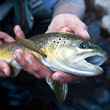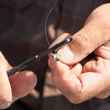On a rainy December morning, I was sitting at my desk drinking my morning coffee when an excited text message came in from one of my best smallmouth clients and friends.
”Beginners luck, for sure!”
Somewhere in middle Tennessee, on their first attempt at throwing flies at musky, the guys boated a beautiful upper-30s musky on a fly. Later that day, they boated a second.
The video that came through showed two very excited anglers roping a fish to the boat, tailing it, and swinging it in the boat for a quick shot before putting it back in the river and unhooking it–very responsible behavior given the tools they had at hand. I couldn’t have been happier for them.
“You boys need a net” was still my response.
Every first musky experience takes me back to my own, fishing solo out of a raft on a Virginia mountain river, knee-deep, adrenaline pumped and full of disbelief on the edge of the river after days of fruitless fishing. Thankfully, I did have a net, which was given to me by a friend, but other than a pair of all-purpose pliers, I had none of the catch-and-release tools that I now carry religiously, so many years and fish later–and I could have used them. That 40-inch fish inhaled my double buford–both hooks pinned in the bottom of its mouth–and refused to open its jaws. I managed (after a while) to get my fly out using my pliers and fingers to gingerly pry the fish’s mouth open and pop the hooks, but it took much longer than I would have liked, and I can only hope that my lack of experience and preparedness as a musky surgeon didn’t take a toll on the fish.
But it was true for me, as it was for my friends in middle Tennessee–putting a giant net and a kit of handling and release tools into the boat as a new musky angler with no realistic expectation of actually hooking or landing a musky can feel like a bit of a joke, particularly if you’ve already invested days, weeks, or more to the pursuit, only to come up empty handed. Still, as the sport of musky fishing grows more and more popular, the importance of preparation and good catch-and-release practices cannot be overstated. There are just a few relatively inexpensive tools that every musky angler should have to responsibly handle and release fish, and they should be carried at all times.
Landing Net
Musky can be large fish, and so a large net is the best tool for the job of effectively landing and containing a fish.
Because of the economy of space in smaller crafts, like canoes, kayaks, rafts, and drift boats, a space-conscious option is sometimes necessary.
Avoid cradles–those two-handled mesh scoops–at all costs. They are not only incredibly inefficient at quickly landing a large, thrashing, head-shaking musky that may or may not have hooks hanging out of its mouth, but they also make it very difficult to keep the fish wet and happy while you grab release tools, remove hooks, and prepare to take photographs.
A better option when space in the boat is a primary concern is a deep-bagged net that folds or slides into itself. Companies like StowMaster and Ranger make good ones.
If you have the space, my favorite musky net is the Solo Slimer made by RS Nets. A wide, deep bag makes it easy to net fish and keep them submerged with the frame of the net on the gunnel of the boat while you do whatever you need to to prepare to release the fish.
When considering a landing net, look for rubber-coated bags with a two-inch mesh or smaller. Musky love to roll in nets, and net bags will snag teeth and jaw mandibles. Larger meshes may grab gill covers, potentially doing damage to gill filaments, particularly in smaller fish. The less-abrasive the bag material, the better.
Of the tools listed here, a net will likely be the most expensive. However, it’s a tool that you’ll use on every fish you catch, is arguably the most critical to the safety of the fish, and will even put fish that you wouldn’t have caught without it–poorly hooked, or otherwise–in the boat.
Jaw Spreaders
A quality pair of jaw spreaders works just as much for the safety of the fish as it does your hands.
Musky have incredible jaw power, and at times will engulf flies and land in the net with their jaws clamped shut and no fly in sight. Using your hands to try to pry them open will result in bloodshed, and using pliers will inevitably cause the fish unnecessary harm while leaving you without a hook-removal tool.

My favorite jaw spreaders are a ratcheting model made by O’Pros in Wisconsin. Other styles have sharp points that can harm fish, and open very powerfully to one very wide position, making it next to impossible to use on smaller fish without doing serious damage to their mouths and jaws. Since adding a ratcheting jaw spreader to my tool arsenal, I’ve used them much more often than I ever used my simple, spring-loaded pair, and I know it’s saved me time in releasing fish.
Regardless of the pair you buy, jaw spreaders cost just a few bucks, and are a necessary tool.
Hook Cutters
In a decade or so of fishing for them, and having put hundreds of hooks in musky and removed them, I have used my hook cutters just a handful of times. However, every time I’ve had to use them they’ve likely saved the fish’s life.
With flies–often tied on just a single hook, or on multiple single hooks linked together with wire or articulating shanks–it’s incredibly common to hook a musky in the corner of the mouth with just a single hook point, which makes unhooking them a breeze. Still, there are times when two hooks get eaten, and both dig into the fish’s mouth at different angles, making it difficult or impossible to remove both hooks. Other times, the fish gets hooked and manages to bend the hooks such that they can’t be removed in their altered state. In these situations, cutting the hooks often allows you to remove the points of them very easily, or otherwise allows you to remove most of the fly, allowing the fish to be released and continue living its life and feeding freely.
Hook cutters can also serve as a very useful first-aid tool in the event that someone in the boat ends up with a musky fly in their neck, arm, or back.
These tools can range in expense from the generic $10-20 to top-of-the-line Knipex compact bolt cutters. Regardless of which pair you buy, just have a pair on board when your goal is to put a hook in a fish.

Long Pliers
It might go without saying that your goal when removing hooks from a musky’s mouth should be to stay as far away from the fish’s teeth as possible. For that reason, though any pair of pliers are better than no pair of pliers, the best tools for releasing musky are long, with beefy, powerful points.
Over the years I’ve had several pairs of very inexpensive, hardware store brand, 10-14-inch needle nose pliers. All have done the job well, and can be a quick and easy way to outfit your boat kit, with the understanding that they may (will) rust without a rust-resistant, stainless build.
Currently, Loon makes my favorite pair of musky pliers — the Apex Needle Nose Plier (pictured at top) — and my original pair show no signs of rust.
Final Word
Barring the purchase of a suitable net, for very little money a musky angler can acquire all the necessary tools to successfully and safely release an incredibly valuable fish. Do yourself and the resource a favor and do so.






























Comments
Ian Burnes replied on Permalink
I would add a float or a lanyard to the jaw spreaders. Getting hooks out of a big fish can be chaotic and often requires you to take your hands off the spreaders, hold the fish with one hand and work the hook with the other. One big head shake can send those spreaders flying --and you be glad you put a float on them.
Michael R Horst replied on Permalink
An excellent article for a newb Musky Hunter like myself. They are too grand a fish to not return to the water to be caught another day!
Pages